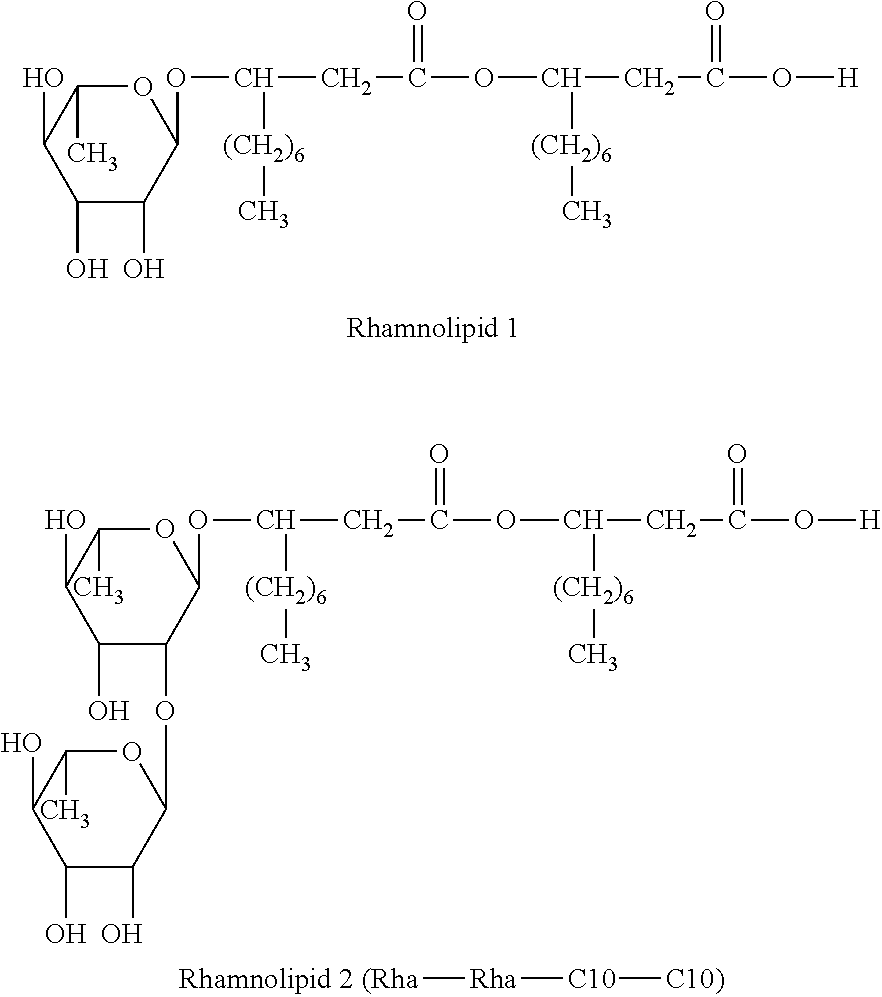Method for treating rhinitis and sinusitis by rhamnolipids
a technology of rhamnolipids and rhinitis, which is applied in the direction of biocide, drug composition, immunological disorders, etc., can solve the problems of nasal mucus, nasal mucus, nasal mucus that is normally thin, clear liquid, and can become thick or colored,
- Summary
- Abstract
- Description
- Claims
- Application Information
AI Technical Summary
Benefits of technology
Problems solved by technology
Method used
Image
Examples
example 1
[0085]A deionized water solution of rhamnolipids (JBR 515, a mixture of R1 and R2) at 15% concentration was obtained from Jeneil Biosurfactant Co., LLC (Saukville, Wis.). The rhamnolipid solution was diluted in water to 0.5% (w / w) and applied to a subject that suffered from perennial rhinitis. The same 0.5% (w / w) rhamnolipid formulation was also used in
examples 3-8
[0086]The 0.5% rhamnolipid formulation was applied to the subject. A standard Q-Tip was dipped into the 0.5% rhamnolipid formulation and then the Q-Tip was applied gently onto the intranasal areas of the subject; the subject's intranasal area had eschars due to excessive mechanical rubbing of the assessable intranasal areas with paper handkerchiefs for excessive itching and nasal discharge associated with his perennial rhinitis.
[0087]The symptoms of his allergic rhinitis (nasal congestion, nasal hypersecretion, and sneezing) disappeared almost immediately for approximately 4 hours.
[0088]After 4 hours on the day of the first administration, the subject re-administered the same amount of rhamnolipid solution into both nostrils at approximately 2200 h, but as far into the intranasal space as was comfortable and swiped the intranasal surfaces that could be comfortably assessed. The subject repeated this on the opposite side, again using a standard Q-tip soaked with the 0.5% rhamnolipid ...
example 2
Objective
[0090]The objective of this study was to evaluate the efficacy of rhamnolipid in treating rhinitis in an animal model.
Material
Animal:
[0091]Female BALB-c mice each weighing 20-30 grams were used in this study.
[0092]The followings were used to sensitize the mice:[0093]1. 0.5 ml saline (0.9% sodium chloride), containing 25 μg of OVA (grade V, Sigma Chemical Co., St. Louis, Mo., USA) and 2 mg of aluminum hydroxide (alum) (pH 5.5, 308 mOsmol L−1) were used as intraperitoneal injection;[0094]2. 5 μl of 5% ovalbumin solution in saline was instilled in each nostril. Isoflurane (an anesthetic agent) was given prior to the intranasal administrations.
Rhamnolipids:
[0095]5 μl of 0.5% rhamnolipids (ABI-100, a mixture of rhamnolipid 1 and rhamnolipid 2) in saline was administered for each nostril.
Method
[0096]Mice were sensitized by 5 weekly intraperitoneal injection of ovalbumin (at Day 1, 8, 15, 22, and 29). After the 5 weekly intraperitoneal injections, from Day 32-50), mi...
PUM
| Property | Measurement | Unit |
|---|---|---|
| Fraction | aaaaa | aaaaa |
| Fraction | aaaaa | aaaaa |
Abstract
Description
Claims
Application Information
 Login to View More
Login to View More - R&D
- Intellectual Property
- Life Sciences
- Materials
- Tech Scout
- Unparalleled Data Quality
- Higher Quality Content
- 60% Fewer Hallucinations
Browse by: Latest US Patents, China's latest patents, Technical Efficacy Thesaurus, Application Domain, Technology Topic, Popular Technical Reports.
© 2025 PatSnap. All rights reserved.Legal|Privacy policy|Modern Slavery Act Transparency Statement|Sitemap|About US| Contact US: help@patsnap.com

